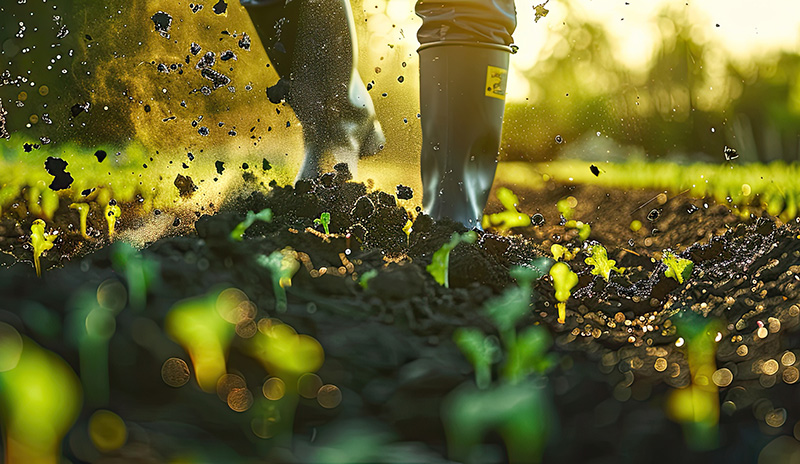Improve Deer Hunting in Iowa

Deer Hunting in Iowa
I recently had a conversation with Justin Synan (of Whitetail Addictions and The Run’n and Gun’n Podcast) about what it is like and how to improve, deer hunting in Iowa. We discussed how most of the state is in row cropped acres. Not really offering much in the way of whitetail habitat. Throughout the vast majority of the state, if the landowner/manager puts in some effort to improve the habitat value on their hunting property they can really make their farm stand out as a destination spot for deer. The starting point to improve deer hunting in Iowa is making these habitat enhancements by defining what type of hunting property you have.
Timbered Draws and Small Timber Patches Surrounded by Ag Fields
I’m not sure how many of our 99 counties I have been in. I’ve certainly spent significant time in all four corners of our state and most places in the middle. As an avid shed hunter and bow hunter I have visited these counties. With eyes open for what they have to offer in the way of deer habitat. Some counties present much more deer habitat than others. The majority of the state consists of ag fields with small woodlots, and timbered draws standing on the unfarmable acres. This type of habitat has produced solid hunting opportunities for Iowa hunters through the decades. Such small amounts of habitat are subject to significant fluctuations in deer presence from year to year. The only way to improve its predictability is by expanding the available habitat. The obvious improvement is adding trees, but there’s a reason there aren’t many trees on these farms, they have a lot of tillable acres, and before farming came around, they were probably prairie acres.
A Way to Start
Convincing a landowner, or even yourself to forest such acres may be too much to ask for. You could start by planting prairie around the existing timber can greatly elevate the deer habitat available. All without making such a permanent commitment to a new form of cover for the farm. Start by visiting with your county NRCS agents to determine if your acres are able to be enrolled into CRP (conservation reserve program), CSP (conservation stewardship program), or EQIP (environmental quality incentives program) to provide cost sharing, or even annual payouts for establishing new prairie. Keep in mind that your added prairie acres will need to be at least as many as the habitat acres you already have in order to see a significant uptick in the number of deer regularly living on your farm.
It’s also important to use a native seed mix that includes a lot of species diversity. This will help receive the maximum amount of bedding and feeding benefits for your deer herd. The primary benefits of planting all of this prairie would be a healthier ecosystem. For the birds (both ground nesting and song birds), pollinating insects and other mammals. The additional prairie would also improve water quality, sequester carbon, and retain soil on the most erodible acres all while increasing population carrying capacity for the deer.
Overgrown Pasture
The next most common deer habitat I’ve seen around Iowa are farms with young forests and old livestock pastures. These farms are typically dominated by cedar trees, honey locusts, cottonwoods, and nonnative cool season grasses. They also typically have some rather large blocks of forest around creek and river bottoms. Historically they have been forested and unsuitable for crop production. From my experience hunting and shed hunting these farms, they can offer an all or nothing experience. Oftentimes these types of farms are so fragmented that deer, especially bucks, won’t frequent them. This is because the habitat doesn’t flow well with other larger forests or prairies which I personally think causes deer to feel unsure about making a clean escape when they feel threatened.
The best way to improve this type of deer hunting habitat is by improving the grass acres. Nearly all pastures in Iowa are dominated cool season grasses, which offer very little habitat value. The first step for improving this type of habitat is to remove the existing nonnative cool season pasture grasses. This is the toughest part of the process because it requires herbicide usage, fire, and time. In this habitat type there are often existing remnant prairie species that are being suppressed by the nonnative grasses and once the competition is removed, the native plants can finally thrive.
Transforming your Land
To begin transforming an old pasture into native prairie habitat. Start by applying glyphosate in mid-April to kill off the existing pasture grasses. Before applying the herbicide, check the weather forecast. Ensure that no temperatures will drop below 40°F for at least 3–4 days, including overnight. After the herbicide has taken effect and the vegetation has died, conduct a prescribed burn to remove the dead plant material. Once the area has been burned, observe the regrowth throughout the summer. If mostly nonnative cool-season grasses return, apply a second round of glyphosate in late summer or early fall while those grasses are still green and before they set seed. If mostly native grasses and forbs reappear, apply spot treatments only where nonnative plants persist. In either case, wait until December, when soil temperatures are too cold for germination, and interseed with a diverse mix of native prairie species. This process enhances habitat for deer, turkey, pheasants, pollinators, and songbirds.
Vast Timber
Removing the Invasive Plants
The least common deer hunting habitat type in Iowa are vast blocks of timber. As uncommon as these are throughout the majority of the state. Deer hunters in the Northeastern, Southeastern, and South-central portions of the state know how productive these areas are for deer populations. If you are fortunate enough to manage properties with this type of habitat your management plans should center mostly around eliminating invasive species, creating edge, and keeping the understory productive.
You probably have recognized a theme here in this article. Always start habitat improvement work with removing invasive plants this will inturn improve deer hunting in your Iowa property. That doesn’t change in this case. The most common invasive species that have invaded the timbers of Iowa are multiflora rose, bush honeysuckle, and buckthorn. All of these plants can spread through the timber like a sickness. Choking out the ground level productivity of native shrubs, forbs and young native trees. Spending some time in early spring removing them will do wonders for the long-term health of the timber, and the deer carrying capacity. Unfortunately, this is a chore that will always have to be part of the management plan for the forest, as invasives will always be trying to weasel their way back into the understory.
Removing Timber
Once the invasives have been removed it’s time to begin selecting low value (both logging value and ecological value) trees to harvest from the timber. Of course, all native trees play an important role in the ecosystem. Only if they are kept in the correct quantities in the timber. An overabundance of hackberry, maple, locust, and redbud can crowd out more valuable trees in the forest such as oak, hickory, cherry, and walnut. Thinning (but not eliminating) some of the lower value trees will help release the higher value trees to thrive within the forest. The thinning of the tree canopy will also help ground level cover to regenerate. This is crucial for deer habitat, especially fawning habitat that keeps them out of sight of predators.
Clear Cutting
Clearcutting is a habitat management strategy that should be used sparingly to create powerful results. The only time I personally would recommend it is if the property is primarily forest. Deer need forest, but they are true creatures of the edge. Preferring to travel where forest transitions into prairie, ag fields, or food plots. Yesterday I saw this play out when I visited a 52-acre property my brother just purchased which is almost entirely forested. The property was logged within the past two. The variance in the habitat created the edge where deer felt most comfortable moving. My brother and I are already formulating plans for incorporating prairie into the large openings, and clover plantings for stabilizing the logging roads. Of course, we will need to take soil samples to identify nutrient and pH needs. Before planting prairie and clover into forest soils. Once the new plantings are installed, I look forward to seeing how my brother finds success hunting these new transitional areas of his property. While I look forward to seeing the ecological response from adding diversity to his landscape.
Land management is a rewarding evolution for many deer hunters. Matching the right land management decisions to the type of existing habitat is critical. Making changes to the habitat that elevates the entire ecosystem is also an important guideline to follow when making the changes in order to promote the healthiest living conditions for Iowa’s favorite critter, and the rest of the biotic community.
By Kent Boucher
June 2025
Here is another article from this months issue of the Iowa Sportsman –
Also check out this article about Deciding whether or not to use a Saddle
Please also come look at our other websites

